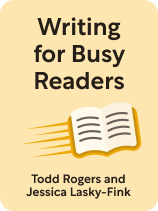

This article is an excerpt from the Shortform book guide to "Writing for Busy Readers" by Todd Rogers and Jessica Lasky-Fink. Shortform has the world's best summaries and analyses of books you should be reading.
Like this article? Sign up for a free trial here.
Why are some writers more successful than others at connecting with readers? How can you write more effectively?
According to behavioral scientists Todd Rogers and Jessica Lasky-Fink, successful writers write effectively. In Writing for Busy Readers, Todd Rogers and Jessica Lasky-Fink offer evidence-based techniques you can use to improve your impact and increase your reach no matter what you’re writing about.
Continue reading to learn why effective writing is so important and for the eight-step process to improve your writing.
Overview of Writing for Busy Readers
We’re all readers and writers—we read and write emails, work memos, social media posts, texts, and more. But many writers face a frustrating problem: The content they write doesn’t get the attention they feel it deserves. In Writing for Busy Readers (2023), Todd Rogers and Jessica Lasky-Fink argue that you can solve this problem by writing more effectively. To do so, you must convince readers your content is worth engaging with and communicate your ideas clearly. Based on the science of human cognition, communication, and behavior, Rogers and Lasky-Fink offer writing tips and techniques to help you maximize your writing’s impact and reach.
Rogers and Lasky-Fink’s writing expertise comes from extensive research and professional experience, including work on writing to voters, families, and political constituents during the pandemic. Rogers is a behavioral scientist and professor of public policy at Harvard University, where he studies the impact of effective communication on human behavior. He’s also the cofounder of the Analyst Institute and EveryDay Labs, which aim to increase engagement among voters and students, respectively. Lasky-Fink is also a behavioral scientist, and she serves as the research director of Harvard’s The People Lab, which studies how governments can better serve their communities.
In this guide, we’ll define effective writing and explore its benefits. Then, we’ll explain how you can write more effectively, organizing Rogers and Lasky-Fink’s recommendations into an eight-step process. In our commentary, we’ll explore why effective writing is valuable from cultural and neurological perspectives, and we’ll share other writing experts’ advice.
Why You Should Write Effectively
Every piece of writing has a purpose—for example, you might write marketing emails to alert customers to flash sales or political flyers to inform citizens about a politician’s campaign.
To achieve your writing’s purpose, Rogers and Lasky-Fink argue that you must write effectively. Let’s explore what that means and its benefits.
What Is Effective Writing?
According to Rogers and Lasky-Fink, effective writing conveys essential information without unnecessary complexity. It’s purposeful—that is, it’s tailored to have a particular impact on readers. It’s also clear, concise, and direct to accommodate readers’ time limitations.
The authors note that almost every reader has limited time: The world is busier than ever, and we’re constantly inundated with information. To cut through the noise, effective writers make it easy for readers to quickly understand their message, its relevance and importance, and how to act on the information it contains. As we’ll discuss, this convinces readers that your content is worth engaging with, ensuring that your ideas have a greater impact by reaching more people.
Effective writing is distinct from literary writing—the kind of writing used in novels and other creative content—which is intentionally complex because readers enjoy taking time to parse its meaning and appreciate the beauty of its language. In contrast, Rogers and Lasky-Fink say to use effective writing when trying to convey information, solve problems, or prompt specific actions. For example, you can use effective writing techniques to announce an event, provide instructions, and convince others of your viewpoint.
Benefits of Writing Effectively
According to Rogers and Lasky-Fink, effective writing has two primary benefits: First, it captivates readers. Second, it’s more impactful than other kinds of writing. Let’s explore each benefit in more detail.
Benefit #1: Effective Writing Captivates Readers
The authors explain that readers want to read effective writing; they’re not likely to ignore it the way they do ineffective writing. People tune out ineffective writing because humans’ capacity for attention is inherently limited. Our brains constantly take in vast amounts of information—so much that we can’t make sense of it all. As a result, we make unconscious choices about what to focus on and what to ignore. For example, right now, you’re focused on reading this guide, so you might be tuning out your dog’s snores or your phone’s notifications. But focusing is difficult work; it requires significant brainpower to ignore distractions and resist the urge to multitask, and your focus can be depleted relatively quickly.
Since readers’ attention is limited, you must convince your audience that reading your content should rank high on their list of priorities. When a reader comes across a piece of writing, they make an instant, intuitive decision about how deeply to engage with it by weighing its benefits (for example, learning about an issue they care about) against its costs (time and energy). The authors note that this analysis forms the basis of most human decision-making: We naturally prefer experiences that require low effort but yield immediate rewards.
Rogers and Lasky-Fink say the more effective your writing is, the more likely you’ll capture your readers’ attention. When your content pops up on their screen, they’ll take a quick look at it and understand immediately that it’s easy to focus on, easy to process, and full of valuable information. Since the benefits of reading your content outweigh the costs, they’ll choose to read it.
Benefit #2: Effective Writing is More Impactful
Rogers and Lasky-Fink also state that effective writing is more likely to have the impact you desire on your readers. Since effective writing captivates readers, they’re more likely to interact with, understand, and integrate your message into their worldview. As a result, Rogers and Lasky-Fink argue, effective writing has a positive impact on society.
The authors explain that ineffective writing confuses or even repels readers, particularly those who face barriers like limited literacy. This prevents many readers from understanding and making use of the world’s most important ideas. For example, if a government policy is poorly written, citizens may not understand their rights and responsibilities. Similarly, if a surgical patient is confused by the hospital’s aftercare instructions, they may neglect crucial aspects of their recovery. In contrast, when government policies, medical instructions, and other key communications are written effectively, people can make more informed decisions about their lives, which helps us build a healthier society.
How to Write Effectively
Now that we’ve covered how writing effectively helps you capture readers’ attention and improve society, let’s discuss how you can reap these benefits. In this section, we’ll guide you through eight steps toward more effective writing.
Step 1: Refine Your Purpose
Recall that effective writing is purposeful—you want to convey a specific idea and have a particular impact on readers. To achieve this, Rogers and Lasky-Fink say you must refine your purpose by identifying your goals and aligning them with your readers’ goals. Let’s explore this in greater detail.
Identify Your Goal
To refine your purpose, first identify the goal of your content. According to Rogers and Lasky-Fink, you should ask yourself what key takeaway you want readers to understand, even if they only spend a few moments distractedly skimming your writing. Your goal is to communicate this takeaway as clearly as possible.
Rogers and Lasky-Fink note that there may be more than one takeaway, but your writing should still be pointed. For example, say you’re writing a project update for your team. A pointed message might focus on two related takeaways, such as “We’ve met our deadlines so far, but we need additional input on the marketing plan to stay on track.” If you also want to share details about an upcoming team-building event (an unrelated takeaway), you might put that information in a separate email to maintain clarity and avoid diluting your primary messages.
If you’re not sure what your goals are from the outset, start writing anyway—the authors explain that writing helps you organize your thoughts, and your first draft may illuminate the most valuable takeaways.
Align Your Goals With the Reader’s Goals
Second, refining your purpose requires that you align your goals with your readers’ goals. Rogers and Lasky-Fink explain that if you fail to address what matters most to your audience, readers will ignore or misunderstand your content, and you won’t be able to achieve your purpose. To bridge this gap, you must emphasize why the content matters and is relevant to your specific audience.
For example, if you’re writing a petition about a climate change initiative, you could focus on a specific, relatable takeaway: “Support this initiative to reduce carbon emissions—it will lower local air pollution and protect your community’s health.” By stressing how your goals align with your readers’ goal of maintaining their community’s health, you make your content more engaging, relevant, and actionable.
Other factors to consider are your readers’ biases. Studies show that writers of marginalized identities may face greater skepticism from certain readers, which makes it more difficult for those writers to connect with their audiences. Rogers and Lasky-Fink acknowledge that although it’s unfair, the burden is on the writer to establish credibility and overcome the readers’ biases.
For example, if your target audience is older adults who may perceive younger writers as brash or entitled, then to counter this bias as a young writer, you might adopt a respectful and measured tone and demonstrate empathy for your readers’ perspectives. This approach helps readers believe you’re working toward shared interests, making them more likely to engage with your message.
Step 2: Choose a Structure
Once you have your goal in mind and know how to frame your message so that it resonates with readers, you can write purposefully. But Rogers and Lasky-Fink explain that to achieve your purpose, you must also structure your message in a way that’s easy to follow. A clear structure guides readers through your points logically and helps them retain the most important information. Without a clear structure, you risk your big takeaways getting lost or overlooked.
Here are three tips Rogers and Lasky-Fink offer for structuring your message effectively:
Tip #1: Draw attention to the big takeaway. Make sure readers know your main point early on by using visual cues (like bold text) or explicitly stating it at the beginning. For instance, instead of placing the takeaway at the end of your message, lead with it: “The new policy will improve efficiency by 20%.” This is more effective because readers don’t always make it to the end of a piece of content.
Tip #2: Organize your ideas by relevance. Group similar ideas together to create flow and avoid confusion. For example, when writing a report, keep all details about the problem in one section and your proposed solutions in another, rather than mixing them together. This helps readers follow your thought process and see how each piece of information connects to your main point.
Tip #3: Use headings liberally. Headings help readers quickly navigate your writing and find what’s most relevant to them. For instance, if you send out an email that recaps your team’s latest meeting, you might include headings like “Overview,” “Key Decisions,” and “Next Steps” to help readers easily scan the email and focus on the sections that matter most to them.
Step 3: Craft a Clear Message
After you’ve settled on a structure, it’s time to write your first draft. As you write, focus on getting your point across as clearly as possible. Rogers and Lasky-Fink reiterate that if you confuse your readers, you risk losing their attention or causing them to misinterpret your message. To write clearly, aim for concision and simplicity. Let’s explore each of these concepts in more detail.
Writing Concisely
The authors say that to keep your readers’ attention and drive your point home, you should write concisely. They explain that many writers conflate wordiness with expertise—you may feel you need to write down everything you know about your topic to convince readers that you’re knowledgeable about it. However, readers are often put off by lengthy content since it requires more time and effort to read. They might start reading longform content, but they’re less likely to read it all the way through. Additionally, it’s easier for readers to lose sight of key takeaways if you distract them with tangential information.
So, how can you write concisely? Rogers and Lasky-Fink explain that you should write as little as possible. Start by zeroing in on the main takeaway or takeaways you want to express, and omit tangential information and fluffy asides. Then, as you write about these takeaways, express your ideas succinctly. Use precise language, avoid redundancy, and eliminate unnecessary words or phrases while ensuring your message remains clear and complete.
Writing Simply
In addition to writing concisely, Rogers and Lasky-Fink say you must write simply. Use straightforward language that readers can understand without consulting a dictionary. For example, instead of writing, “Cardiothoracic complications may necessitate immediate medical intervention,” opt for a simpler alternative like “Heart or lung problems may need quick treatment.” The authors explain that readers are more likely to engage with and fully understand your message if you frame it in simple language. In contrast, complex writing is easily misunderstood and mentally taxing to process, which leads readers to lose interest (especially when they’re pressed for time).
Step 4: Include a Call to Action
Once you’ve written a clear message to your readers, include a call to action (CTA): a stimulus that prompts readers to perform a specific action. Rogers and Lasky-Fink note that CTAs aren’t always appropriate; for example, if your goal is simply to inform your audience about new research findings, you probably don’t need a CTA. But if you want to encourage readers to sign a petition, follow public health guidelines, or buy a product, a clear CTA can motivate your audience to take that action when they finish reading your content.
If you decide to include a CTA, Rogers and Lasky-Fink recommend that you make it as easy as possible for readers to perform the desired action by reducing the mental load of 1) deciding to act and 2) following through. For example, instead of giving readers a menu of choices regarding subscription plans, offer them a pre-selected option based on their preferences or needs. Readers are more likely to perform a one-step action like pressing a button to sign up for a subscription than a multistep process that includes deciding which subscription plan is best for them, creating an account, and confirming their selection.
Step 5: Apply Formatting Carefully
Once you’ve written your first draft, look for opportunities to use formatting styles like colorful, highlighted, italicized, bolded, all-caps, or underlined text. Rogers and Lasky-Fink explain that formatting creates visual contrast that helps you guide the reader’s attention to key points. For example, if you bold the main takeaway of your message, it’ll stand out to readers as important—so they’ll be more likely to focus on it and retain that information.
However, the authors explain that formatting is somewhat ambiguous; readers don’t always interpret formatting choices in the ways we intend. Further, if readers are confused about what your formatting choices mean, they might overlook or misunderstand the intended emphasis. The authors provide three tips to guide your decisions about formatting:
- Use highlighting, underlining, and bolding to draw attention to important points. Readers almost universally interpret these types of formatting as a sign of emphasis, so they’ll understand that you’re trying to drive home your point.
- It’s best to avoid writing in all caps. All-caps text is harder for the brain to process, and some readers understand it to indicate hostility instead of emphasis.
- Use formatting sparingly. Too much formatting confuses readers by making the text harder to read. It also makes it more difficult for readers to determine which parts of the text you want them to pay attention to.
Step 6: Revise Your Writing
Once you’ve applied formatting, your draft is ready for revision—the process of reviewing, editing, and refining your writing to improve its effectiveness. The authors argue that you should revise every piece of writing—even simple text messages—multiple times. You want to ensure your writing achieves its purpose, so you should look for and correct anything that could prevent that. So, how do you revise a piece of writing?
First, edit for conciseness. As you read through your writing, ask yourself which parts are truly essential and which you can discard. If you’ve written something valuable but slightly tangential, consider moving it out of the main body of the text into an appendix or attaching it separately.
Second, edit for clarity. Correct any typos or grammatical errors that could distract your reader from your message. Additionally, ask yourself if the message is easy to understand and whether it could be any easier. Rewrite any overly complex sentences, and replace complicated language and jargon with simpler alternatives.
Step 7: Disseminate Your Message
When you’ve completed your revisions and you’re satisfied with the final product, it’s time to disseminate your message. But before you press “send” or “publish,” Rogers and Lasky-Fink recommend that you put some thought into how you’ll disseminate your message. More specifically, they recommend considering your spokesperson, medium, timing, and follow-up strategy.
Who’s Your Spokesperson?
Most of the time, you are your own spokesperson—for example, in your role as a supervisor, you likely send emails directly to your staff. But Rogers and Lasky-Fink explain that if you’re writing on behalf of an organization or collective, you might be able to choose a spokesperson other than yourself. If so, choose one who resonates with your audience and aligns with the message’s purpose. To select the right spokesperson, you must know your audience well; different speakers will appeal to different readers. For example, elderly readers may prefer to hear from people in their age range over younger sources.
What Medium Will You Use?
As a general rule, the authors recommend that you ask your audience how they’d prefer you communicate with them whenever possible. In our increasingly digital world, many writers assume that digital communications like texts and emails are the best way to reach people. But that’s not always the case—paper communications may better capture readers’ attention because they’re less common. Additionally, it’s important to keep in mind that not everyone can easily access technology. For example, it may be better to print out (rather than email) surgical aftercare instructions, so there’s no chance a patient won’t have access to them.
When Will You Share Your Content?
Ideally, you want your content to reach readers at a time when they’re free to engage with it. The optimal time to share content will vary depending on who your audience is, so it’s important to know your audience and anticipate their schedules. For example, if you’re writing to busy moms, it’s probably best to avoid sending a mass text during school pick-up or drop-off times. Rogers and Lasky-Fink also recommend timing your message so readers have enough time to act on your CTA. However, you don’t want to send it out too early, or you risk your readers forgetting about it.
How Will You Follow Up?
After you disseminate what you’ve written, you may want to follow up with your audience—especially if you’re asking them to take a particular action. Reminders can be effective, but Rogers and Lasky-Fink warn against sending too many. Excessive follow-ups overwhelm your audience—you likely know this firsthand if you’ve ever unsubscribed from, muted, or even blocked a sender who bombarded you with messages. If you choose to follow up multiple times, consider switching up your approach to keep readers’ attention. For example, as the deadline for taking action approaches, adopt a more urgent tone and use more compelling language.
Step 8: Keep Practicing
Rogers and Lasky-Fink explain that effective writing isn’t likely to come naturally to you (or any writer); rather, it’s a skill you must hone with practice. Therefore, you should practice effective writing often. Continual practice also helps you keep up with changing communication norms and writing tools. For example, you may find that as the world grows busier and readers become more pressed for time, concise and visually engaging formats—like lists, infographics, or short videos—may prove more effective than long-form text.
Exercise: Practice Writing Effectively
Consider how to use effective writing principles the next time you write.
- Think of something you need to write in the near future—an email to your boss, an invitation to a party, or a business plan. What’s your purpose in writing it? What’s the key message you want readers to take away?
- Next, step into your readers’ shoes and think about their priorities. What makes what you’re writing relevant to them? Do they have any biases you need to strategize around?
- What’s the best way to structure this piece of writing? Write a simple outline in the space below.
- Do you want to prompt your readers to take a specific action? If so, you’ll need to include a call to action. Brainstorm one now.
- How do you plan to disseminate this message? Consider factors like what medium you’ll use, when you’ll share it, and whether and how you’ll follow up.
Exercise: Become a Better Writer
Rogers and Lasky-Fink argue that learning to write effectively takes practice. In this exercise, reflect on how you can build that practice into your daily routine.
- What’s one area of writing you’d like to improve (for example, conciseness, tone, structure, or persuasiveness)?
- How will you practice this skill? For example, will you journal daily, revise old drafts, or write short posts for social media?
- When and how often will you practice? Set a realistic schedule—remember, even five to 10 minutes a day can add up over time.
- How will you track your progress? For example, you might keep a log, revisit old pieces to look for improvement, or ask for feedback from a trusted reader.

———End of Preview———
Like what you just read? Read the rest of the world's best book summary and analysis of Todd Rogers and Jessica Lasky-Fink's "Writing for Busy Readers" at Shortform.
Here's what you'll find in our full Writing for Busy Readers summary:
- Why some writers are so successful at connecting with readers while others aren't
- How to make your writing more impactful and increase your reach
- That how you communicate can be just as important as what you say






